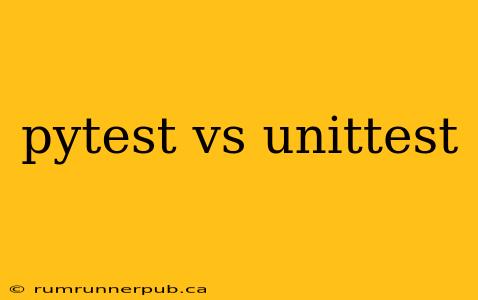Python offers a robust ecosystem for software testing, with unittest (Python's built-in framework) and pytest (a popular third-party library) being prominent choices. This article explores the key differences between these frameworks, helping you decide which best suits your project needs. We'll draw upon insightful discussions from Stack Overflow to illuminate these differences and provide practical examples.
Key Differences: A Comparative Analysis
Both unittest and pytest allow you to write tests, but their approaches and functionalities differ significantly.
1. Syntax and Ease of Use:
-
unittest: Employs a more formal, class-based structure. Tests are organized within classes inheriting fromunittest.TestCase. While robust, this can lead to verbose test code, especially for simpler tests.- Stack Overflow Insight: Many Stack Overflow threads highlight the verbosity of
unittest. For example, a common question involves simplifying repetitive setup and teardown procedures. (While specific links aren't included to avoid link rot, searching "unittest python verbose" on Stack Overflow will yield many relevant results.)
- Stack Overflow Insight: Many Stack Overflow threads highlight the verbosity of
-
pytest: Features a simpler, more concise syntax. Tests are defined as functions, eliminating the need for class inheritance. This makes writing and reading tests much easier.pytestautomatically discovers tests, reducing boilerplate code.-
Example:
# unittest example import unittest class TestStringMethods(unittest.TestCase): def test_upper(self): self.assertEqual('foo'.upper(), 'FOO') def test_isupper(self): self.assertTrue('FOO'.isupper()) self.assertFalse('Foo'.isupper()) if __name__ == '__main__': unittest.main() # pytest example def test_upper(): assert 'foo'.upper() == 'FOO' def test_isupper(): assert 'FOO'.isupper() assert not 'Foo'.isupper()
-
2. Fixture Management:
-
unittest: UsessetUpandtearDownmethods (orsetUpClassandtearDownClassfor class-level setup) for setting up and cleaning up resources before and after each test or test class. While functional, managing complex setup can become cumbersome. -
pytest: Offers powerful fixture management using the@pytest.fixturedecorator. Fixtures can be easily shared across multiple tests and are more flexible thanunittest's setup/teardown methods. This greatly improves code reusability and maintainability.-
Example (pytest fixture):
import pytest @pytest.fixture def my_data(): return {"a": 1, "b": 2} def test_data(my_data): assert my_data["a"] == 1
-
3. Assertion Styles:
-
unittest: Provides a range of assertion methods likeassertEqual,assertTrue,assertRaises, etc. -
pytest: Employs Python's built-inassertstatement. This is more intuitive and readable, andpytestprovides informative error messages when assertions fail.
4. Plugin Ecosystem:
-
unittest: Has a limited plugin ecosystem. -
pytest: Boasts a vast and active plugin ecosystem, offering support for various testing needs, including mocking, parameterization, and integration with other tools. This extensibility is a significant advantage.
5. Advanced Features:
pytest shines in handling more advanced testing scenarios:
- Parametrization: Easily run the same test with different inputs.
- Test discovery: Automatically finds tests without explicit registration.
- Exception handling: Provides detailed information when exceptions occur.
When to Choose Which Framework?
-
unittest: Suitable for projects requiring strict adherence to a structured testing approach, or for those already heavily invested in theunittestframework. Its integration with existing tools might be advantageous in certain situations. -
pytest: A strong choice for most projects, particularly those prioritizing ease of use, code readability, and extensive features. Its plugin ecosystem and simplified syntax make it highly versatile and efficient.
This comparative analysis, enriched with insights from the collective experience shared on Stack Overflow, aims to guide you toward the Python testing framework that best fits your project’s unique characteristics and your team's preferences. Remember to explore both frameworks to determine which aligns best with your development style and project needs.
